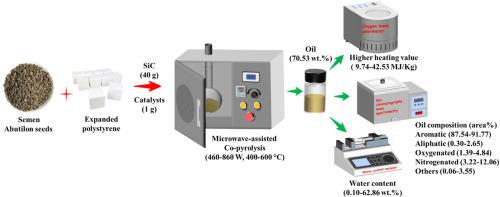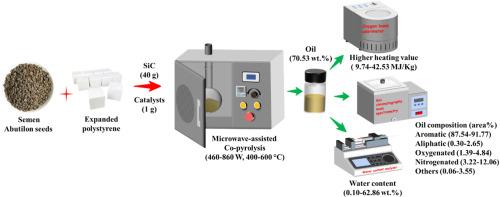Aromatic enriched oil production via microwave-assisted catalytic co-pyrolysis of baked semen abutilon seeds and waste expanded polystyrene
IF 10
1区 环境科学与生态学
Q1 ENGINEERING, ENVIRONMENTAL
引用次数: 0
Abstract
Co-pyrolysis of biomass and plastic waste presents a promising strategy for waste valorization and fuel upgrading. This study explored microwave-assisted co-pyrolysis of expanded polystyrene (EPS) and Semen Abutilon seeds (SAS) using metal oxides (Al2O3, CaO), inorganic salts (Na2CO3, Fe(NO3)3·9H2O), and zeolite (ZSM-5) as catalysts. The effects of catalyst type, microwave power (460–860 W), and pyrolysis temperature (400–600 °C) on oil yield and composition were evaluated. Using an EPS:SAS blend ratio of 2:1, optimal conditions were identified as 660 W and 500 °C, with CaO emerging as the most effective catalyst, achieving a maximum oil yield (70.53 wt%), thermal efficiency (47.33 %), and recovery efficiency (98.83 %). Compared to non-catalytic pyrolysis (52.02 wt%), CaO and Al2O3 increased oil yield by 35.56 % and 25.94 %, respectively, showing positive synergistic effects of 10.13 % and 2.79 %. The use of Fe(NO3)3·9H2O resulted in oil with a high-calorific value (42.53 MJ/kg), while ZSM-5 reduced water content (from 12.60 to 3.37 wt%). Although SAS-derived oil was rich in oxygenated hydrocarbons (74.92 area%), catalytic co-pyrolysis promoted deoxygenation and aromatization reactions, yielding oil high in aromatic hydrocarbons (87.54–91.77 area%). These results confirm SAS and EPS as synergistic feedstocks capable of producing high-quality oils through microwave-assisted co-pyrolysis.


微波辅助催化共热解烤锦鸡子和废膨胀聚苯乙烯生产富香油
生物质和塑料垃圾的共热解是一种很有前途的废物增值和燃料升级策略。以金属氧化物(Al2O3、CaO)、无机盐(Na2CO3、Fe(NO3)3·9H2O)和沸石(ZSM-5)为催化剂,对膨胀聚苯乙烯(EPS)和Abutilon种子(SAS)进行了微波助热解研究。考察了催化剂类型、微波功率(460 ~ 860 W)、热解温度(400 ~ 600℃)对油脂收率和组成的影响。在EPS:SAS配比为2:1的条件下,最佳条件为660 W和500°C,其中CaO是最有效的催化剂,获得了最大的油收率(70.53 wt%)、热效率(47.33%)和回收率(98.83%)。与非催化热解(52.02 wt%)相比,CaO和Al2O3分别提高了35.56%和25.94%的产油率,表现出10.13%和2.79%的正协同效应。使用Fe(NO3)3·9H2O得到的油具有较高的热值(42.53 MJ/kg),而ZSM-5降低了水含量(从12.60 wt%降至3.37 wt%)。虽然sas衍生油中含丰富的芳烃(74.92面积%),但催化共热解促进了脱氧和芳构化反应,得到芳烃含量高的油(87.54 ~ 91.77面积%)。这些结果证实了SAS和EPS作为协同原料能够通过微波辅助共热解生产高质量的油。
本文章由计算机程序翻译,如有差异,请以英文原文为准。
求助全文
约1分钟内获得全文
求助全文
来源期刊

Journal of Cleaner Production
环境科学-工程:环境
CiteScore
20.40
自引率
9.00%
发文量
4720
审稿时长
111 days
期刊介绍:
The Journal of Cleaner Production is an international, transdisciplinary journal that addresses and discusses theoretical and practical Cleaner Production, Environmental, and Sustainability issues. It aims to help societies become more sustainable by focusing on the concept of 'Cleaner Production', which aims at preventing waste production and increasing efficiencies in energy, water, resources, and human capital use. The journal serves as a platform for corporations, governments, education institutions, regions, and societies to engage in discussions and research related to Cleaner Production, environmental, and sustainability practices.
 求助内容:
求助内容: 应助结果提醒方式:
应助结果提醒方式:


